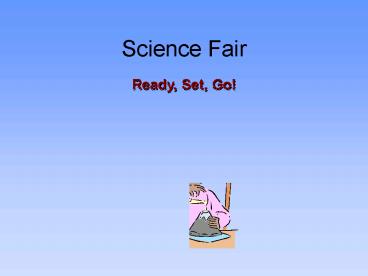Science Fair - PowerPoint PPT Presentation
1 / 13
Title:
Science Fair
Description:
February 28 Entry Forms due for Southern Appalachian Science and Engineering Fair ... April 9 SASEF Awards Ceremony ... A Science Fair project is an ... – PowerPoint PPT presentation
Number of Views:129
Avg rating:3.0/5.0
Title: Science Fair
1
Science Fair
Ready, Set, Go!
2
Timeline and Dates
Jefferson County Schools has formed a partnership
with the Appalachian Electric Cooperative for the
Science Fair.
- February 28 Entry Forms due for Southern
Appalachian Science and Engineering Fair - April 7 Southern Appalachian Science and
Engineering Fair (SASEF) project setup and
judging - April 9 SASEF Awards Ceremony
3
Encourage Students and Parents to Utilize the Web
Page
4
Forms
- Entry form
- Junior Research
- Plan
- Entry Fee
5
Role of the Teacher
- You are an advisor.
- Recognize the need for active student
involvement. - Respect student ideas and help steer them in the
correct direction. - Praise and encourage students.
- Advise students of resources available.
6
Tips for the Students
- A Science Fair project is an investigation not
a demonstration. There is a question that must
be answered. - If they have a demonstration in mind, help them
to alter the thought process to asking a
question What is in _______? Why does this
happen? Can I do this a better way? How does
temperature change the behavior?
7
Components of a Project
- Question or Problem
- Hypothesis If then format
- Methods
- Materials
- Results drawings, pictures, graphs, tables
- Conclusion
DO NOT use I, we, you!
8
Variables
- The independent variable is the one that is
changed by the scientist. In an experiment there
is only one independent variable. - The dependent variable changes in response to the
change the scientist. Experiments also have
controlled variables. - There should be a Control. No experimental
treatment is applied. - Constants are conditions that remain the same for
all parts of the experiment, such as measuring
the water, always by a window, same position in
the room, etc.
9
Display Board
- Arrange information so that it is easy to read
and flows in a logical order. - Top to bottom and left to right.
- Presentation boards (32 x 48), awards, etc. may
be ordered from EPI. (800-426-2737 or
www.epidisplays.com)
10
Examples
No living or dead organisms in the display
(plants or animals).
11
Sample Materials List( From Science Buddies)
- CD player a CD (low drain device)
- Three identical flashlights (medium drain device)
- Camera flash (high drain device)
- AA size Duracell and Energizer batteries
- AA size of a "heavy-duty" (non-alkaline) battery
(I used Panasonic) - Voltmeter a AA battery holder
- Kitchen timer
12
Sample Procedure( From Science Buddies)
- Number each battery so you can tell them apart.
- Measure each battery's voltage by using the
voltmeter. - Put the same battery into one of the devices and
turn it on. - Let the device run for thirty minutes before
measuring its voltage again. (Record the voltage
in a table every time it is measured.) - Repeat 4 until the battery is at 0.9 volts or
until the device stops. - Do steps 15 again, three trials for each brand
of battery in each experimental group. - For the camera flash push the flash button every
30 seconds and measure the voltage every 5
minutes. - For the flashlights rotate each battery brand so
each one has a turn in each flashlight. - For the CD player repeat the same song at the
same volume throughout the tests.
13
Board Titles
- INTRODUCTION
- BACKGROUND
- PROBLEM
- HYPOTHESIS
- PROCEDURE
- DATA
- RESULTS
- MATERIALS
- CONCLUSION
- ACKNOWLEDGEMENTS































